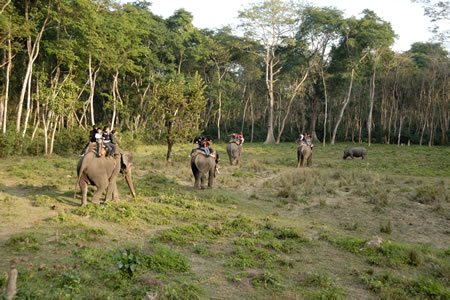English | Dutch |
|
| On Safari with the Nepalese | |
Janakpur (Nepal), January 10th 2008 |
|
At 15:00 o’clock are we waiting to jump on our elephant to start our elephant safari through the buffer zone of Chitwan National Park. Yesterday, we already saw a One Horned Indian Rhino within the boundaries of the National Park, but they say that there even more Rhinos in the buffer zone next to the park. The chances of seeing a Rhino during this safari is said to be 99%, so we have high expectations. This optimism is reduced when we see with whom we share our elephant. We share our jumbo with two Nepalese adults and a child. On another elephant are five other members of the family and all experiences are yelled from one elephant to the other. While we really like the Nepalese in general, we already noticed in Bardia National Park that most of them are not really interested in wildlife spotting. Surely, they like to see the animals but they are not willing to “work” for it. Sitting for hours in a watching tower, or being silent for a while to avoid scaring the animals is too much to ask. Why should they otherwise go on an outing? Our prejudgement seems to be justified. During the half hour that the elephant needs to get from the village to the buffer zone is the elephant stopped for some shopping. It doesn’t matter for them that this could mean that we are staying shorter inside the forest. We also don’t mind as we already say a Rhino yesterday. Today we are just observing the joy of the Nepalese on an outing. |
|
 |
|
Look, a Rhino! |
|
At the entrance of the buffer zone disappears our last hope of seeing a Rhino today. Approximately ten elephants loaded with scholars are entering the park before us. The fellow passengers on our elephant are asking us many questions about our country and how we like Nepal. All our answers are translated in Nepali and shouted to the family members on the elephant twenty metres before us. In the meanwhile they pop open a bag of crisps and while they enjoy the snack they see a beautiful forest passing by. Most of the elephants are following the same route and when the scholars are noticing us they yell: Cheeeese, can you smile for the picture? The scholars are also opening their bags of crisps and some are using their mobile phones to report back home about what is happening during this school outing. When we burst of laughter about the things that are happening around us, says the elephant driver: look, a Rhino. First we think that he his kidding, but it appears to be true. A Rhino with her baby stands quietly under a tree and looks around while they are surrounded by all the elephants. It’s amazing that they don’t run off with al that noise surrounding them. Again, we feel as if we are in an animal amusement park (see also our Tiger spotting experience in Ranthambhore NP India) and we are not sure about how “wild” these animals are. You can call them wild because they have to take care of their own food and because they are not in a cage. But on the other side are those animals definitely used to this kind of human attention. With the one elephant on the others’ heels are we continuing the journey through the forest. We see another Rhino and after spending 45 minutes in the forest are the elephant drivers heading back to the village. Although we agreed on a two hour ride through the forest, we don’t make a problem of the early return. We had a great afternoon in which we had a good laugh and as a bonus we also saw a Rhino with her baby! Additional advantage of squeezing all those highlights in this shorter period of time is that we are in time to see the sun set at the river side. We toast with a nice cold beer on the Nepalese and our intention that we will try to take wildlife spotting not to serious in the future. Without being quiet you can also see wildlife, if you pick out the right parks. | |